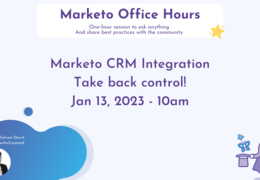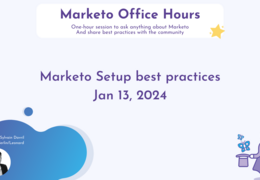Marketo Office Hours
Why your MQLs are not enough anymore - MOH 2025 09 26
8 views
You've invested in marketing automation... but is that enough?
You've deployed Marketo, built your nurturing scenarios, set up your scoring, and aligned your campaigns.
Your reports show rising MQLs, and your workflows are running like clockwork.
Well done.
But is that really enough to generate business?
Not quite.
Most B2B marketing departments face the same problem: despite a well-stocked lead pipeline, sales are struggling to convert. It's the modern marketing blues.
And it's not a technical execution problem: it's a model problem.
The problem with the traditional funnel
The classic funnel (Visitor → Lead → MQL → SQL → Opportunity) was designed to simplify a much more complex reality.
And we made the convenient assumption that purchasing decisions were linear and individual.
Suddenly, everything became simpler:
Creating tracking metrics,
Evaluating marketing performance,
Setting volume targets.
But by simplifying, the model became reality in many companies:
exclusive focus on MQLs, pressure on quotas, and volume targets disconnected from the real business.
However, modern B2B does not work that way.
Today, a B2B purchase involves several decision-makers, often from different departments, and 70% of the purchasing journey takes place without direct contact with your teams.
The result:
The MQL represents only a fragment of the account,
and the traditional funnel no longer reflects the reality of the purchasing journey.
Limitation #1: Too much volume, not enough focus
Marketing automation has made it possible to generate a lot of leads. Too many, sometimes.
Hundreds of MQLs are generated, but only a handful are truly strategic accounts.
This discrepancy creates noise: sales teams spend their time sorting through leads instead of focusing on the right accounts.
“We have too many MQLs and not enough customers.”
This is a phrase often heard in organizations with mature marketing automation programs.
Limitation #2: MQLs arrive too late
“80% of buyers choose a brand they already know.”
(The Day One List, Bain & Company)
When a contact reaches MQL status, they are often already well advanced in their journey.
Signs of interest—searches, page visits, interactions—have been visible for weeks, but have not been exploited.
As a result, marketing reacts instead of anticipating.
Buyers have already shortlisted their options, sometimes even choosing a competitor.
You're coming into the conversation too late.
Limitation #3: Lack of alignment between Marketing and Sales
Sales says, “These leads aren't good.”
Marketing responds, “But they meet our MQL criteria.”
Both are right.
But each is working according to a different logic:
Marketing thinks in terms of individual leads,
Sales thinks in terms of accounts and opportunities.
This structural misalignment explains why the MQL → opportunity conversion rate remains low, despite all the automation efforts.
The necessary transition to ABM
This is where Account-Based Marketing (ABM) comes in.
ABM offers a radically different approach: moving from lead to account.
Rather than seeking to generate more and more leads, ABM focuses on:
Strategic accounts, those that really matter to the business,
Signals of intent, to detect the right moment for action,
And orchestration between marketing and sales, to send the right message to the right people.
Lead funnel vs. account funnel
In a lead-based funnel, each contact progresses on its own.
In an account-based funnel, it is the entire account that advances in its journey.
Lead-Based Approach ←> Account-Based Approach
Unit = individual ←> Unit = account
Objective = volume ←> Objective = relevance
Individual scoring ←> Collective scoring (Intent + Engagement)
Marketing pushes leads ←> Marketing and sales work together
Measurement = MQL ←> Measurement = account progress
This shift changes everything: marketing becomes a strategic partner in business development.
Key concepts of ABM
Target Account List (TAL)A list of priority accounts defined jointly with sales.
Intent DataAnalysis of search signals to detect accounts “in the market.”
Buying GroupsPurchasing committees to be identified, mapped, and engaged collectively.
PersonalizationAdapting the message and campaigns to the reality of each account.
ABM + Marketing Automation: a powerful combination
Good news: everything you've built with your marketing automation tool (Marketo, Eloqua, HubSpot, etc.) remains useful.
ABM does not replace your existing stack: it guides and reinforces it.
Marketing Automation = the execution engine (nurturing, email, campaigns, scoring)
ABM = the navigation system (targeting, timing, alignment, strategy)
Marketo + ABM is like a powerful engine with smart GPS.
By combining the two, you move from volume-oriented marketing to value-oriented marketing.
In conclusion
Your MQLs aren't dead, but they need to evolve.
MQLs remain a useful indicator, but they can no longer be the sole compass for B2B marketing.
What matters now is the progress of strategic accounts in their buying cycle.
That's the purpose of this new series of Marketing Office Hours: to help marketers move from volume-driven to value-driven management.







Jaime Taylor December 11, 2025 07:12 AM Delete
This is a great point about the limitations of MQLs! I've definitely seen the "too many leads, not enough customers" problem firsthand. Focusing on strategic accounts and intent data makes so much sense in today's B2B landscape. It's like, you can have all the marketing automation in the world, but if you're not targeting the right accounts at the right time, it's just wasted effort. You know, it reminds me of the frustration I feel sometimes when I mess up on Eggy Car and my egg falls right before the goal, you think you've won, but its not over until you actually win! Thanks for sharing!
Dave Jack December 10, 2025 03:04 PM Delete
I suggest any kind of content material. It certainly is fantastic to sort out you'll clarify within phrases through center and also display quality by using this useful content material is very merely acknowledged. bandar toto macau
Dave Jack December 05, 2025 06:11 PM Delete
I am typically to blogging we actually appreciate your site content. This article has truly peaks my interest. I am about to bookmark your site and keep checking for brand spanking new information. UK FAKE DRIVERS LICENSE
Dave Jack December 05, 2025 10:13 AM Delete
강남풀싸롱은 다양한 유형의 풀싸롱을 제공합니다. 목욕탕, 사우나, 반사요법, 피부관리, 비데 등 일반적인 서비스는 물론 다양한 테마와 맞춤 서비스를 제공합니다. 일부 강남풀싸롱
Dave Jack December 05, 2025 10:13 AM Delete
It’s difficult to find knowledgeable people within this topic, but you appear to be do you know what you’re discussing! Thanks alexistogel
Dave Jack December 04, 2025 10:03 PM Delete
비아그라 구매,구입, 비아그라 판매, 비아그라 약국, 비아그라 파는 사이트, 시알리스 구매, 비아그라 파는곳, 온라인 약국 비아그라 재구매율 1위 100% 정품 비아그라 구매
Dave Jack December 04, 2025 09:11 PM Delete
The following appears to be like unquestionably fantastic. Almost all these minor points are built by using number of foundation awareness. I enjoy them considerably toto macau
Dave Jack December 01, 2025 03:08 PM Delete
That'sthe justification selling you ought to correct home work in advance of composing. It is practical to jot down greater offer this particular. situs togel
Dave Jack November 27, 2025 02:02 PM Delete
Thank you for making the sincere attempt to explain this. I feel very sturdy about this and also find out more. If its OK, as you reach more in depth knowledge, would you mind including more posts similar to this one with more information? It might be extremely helpful and great for me and my colleagues. monetization acceleration package
Dave Jack November 27, 2025 01:33 PM Delete
Heya i am for the first time here. I came across this board and I in finding It really helpful & it helped me out much. I hope to present something again and help others such as you aided me. creative network architecture
Dave Jack November 27, 2025 01:07 PM Delete
I do believe all of the ideas you’ve offered to your post. They’re really convincing and will certainly work. Still, the posts are very brief for starters. May just you please lengthen them a little from next time? Thank you for the post. Viral Promotions: A Reliable Source for YouTube Growth
Dave Jack November 27, 2025 12:32 PM Delete
This will be aside from that an amazing guide as i seriously wanted examining. You'll find it not day after day as i retain the scope to determine a product. https://www.dss-hr.com/industrial-engineer-salary-germany
Dave Jack November 27, 2025 08:51 AM Delete
My brother recommended I may like this website. He was once totally right. This put up actually made my day. You can not believe simply how a lot time I had spent for this information! Thanks! https://www.dynamichealthstaff.com/nursing-jobs-muscat
Dave Jack November 25, 2025 02:26 PM Delete
Hey there, I think your blog might be having browser compatibility issues. When I look at your blog in Safari, it looks fine but when opening in Internet Explorer, it has some overlapping. I just wanted to give you a quick heads up! Other then that, awesome blog! gohighlevel crm
Dave Jack November 24, 2025 05:45 PM Delete
대전출장마사지는 호텔, 자택, 오피스 등 어디서나 받을 수 있는 방문형 전문 마사지 서비스입니다. 아로마, 스웨디시, 스포츠, 림프, 풋마사지까지 — 대전 전역 출장 대전출장마사지
Dave Jack November 24, 2025 01:05 PM Delete
하남출장마사지 - 하남 전역에 24시간 여성 전문 마사지사가 찾아가는 출장 홈타이 서비스! 아로마, 스포츠, 커플 마사지로 피로와 스트레스를 합리적 가격에 풀어 하남출장마사지
Dave Jack November 24, 2025 10:54 AM Delete
포항출장마사지 출장마사지 서비스는 24시간 연중무휴로 운영되어 시간 제약 없이 편리하게 이용하실 수 있습니다. 늦은 밤 호텔에 도착한 출장객이나 새벽에 피로를 느끼는 포항출장마사지
Dave Jack November 23, 2025 08:22 AM Delete
강남달토 달토가라오케는 서울 강남구 역삼동 삼정호텔 지하 1층에 위치해 있습니다. 강남역과 역삼역 사이에 위치한 만큼 대중교통으로 찾아오기 쉽고, 강남 번화가 강남달토
Dave Jack November 19, 2025 01:23 PM Delete
Using the pink salt trick daily may enhance hydration, curb appetite, and encourage long-term weight loss success naturally. pink salt trick for weight loss
Dave Jack November 18, 2025 04:24 PM Delete
Spot on with this write-up, I actually think this website needs far more consideration. in all probability be once more to read far more, thanks for that info. corporate asset protection service
David Nelson November 17, 2025 09:48 AM Delete
It's interesting to see this perspective, especially in 2025. We've all been chasing MQLs for so long. It makes sense that the focus needs to shift towards the quality and engagement after that initial lead qualification. Maybe thinking about the whole customer journey as a continuous flow, like mastering the perfect drift in a game like Drift Hunters, could be a good analogy. It's not just about starting the drift (getting the MQL), but maintaining control and direction all the way to the finish line (conversion). Thanks for sharing this insight!
Dave Jack November 16, 2025 11:04 PM Delete
Youre so cool! I dont suppose Ive read anything such as this prior to. So nice to uncover somebody with many original ideas on this subject. realy thank you for beginning this up. this website can be something that is required on the web, a person after some originality. helpful job for bringing new stuff for the web! iblbet login
Dave Jack November 16, 2025 08:00 PM Delete
Its for these reasons it happens to be improved that anyone can helpful test earlier than building. It will be possible to write more piece of writing like this. togel
Dave Jack November 15, 2025 10:40 AM Delete
Unquestionably believe that which you said. Your favorite reason seemed to be on the net the easiest thing to be aware of. I say to you, I definitely get annoyed while people think about worries that they plainly do not know about. You managed to hit the nail upon the top as well as defined out the whole thing without having side effect , people can take a signal. Will likely be back to get more. Thanks https://actual-cosmetology.ru/
Dave Jack November 12, 2025 02:24 PM Delete
대전출장마사지, 24시간 연중무휴! 대전 전 지역 어디든 호텔·자택 방문, 전문 여성 테라피스트의 맞춤 힐링 마사지로 피로 싹 풀기! 위생·안전 관리 철저한 신뢰 대전출장마사지
Dave Jack November 12, 2025 11:25 AM Delete
분당가라오케 - 프라이빗 룸에서 즐기는 노래방! 서현역·정자역 등 분당 주요 역세권에 위치하고, 저렴한 가격과 신곡 빠른 업데이트로 남녀노소 누구나 만족하는 노래 분당가라오케
Dave Jack November 11, 2025 10:37 AM Delete
Very fine write-up. I actually really came across a person’s blog site plus needed so that you can point out this I’ve actually loved browsing a person’s site plus content. Anyhow I’ll often be checking a person’s feast plus I actually hope so that you can examine a person’s site again. bandar slot gacor
Dave Jack November 08, 2025 09:57 AM Delete
This is certainly what's more a good report that i definitely enjoyed reading reviewing. It is actually no regularly that i contain the risk to discover a specific thing. link slot gacor
Dave Jack November 05, 2025 03:09 PM Delete
What a rubbish. How can you refer to it a new web site. Customize the design, so it is going to be a bit better GELATIN TRICK
October 18, 2025 08:35 AM Delete
We’re a group of volunteers and starting a new scheme in our community. Your website offered us with valuable info to work on. You’ve done a formidable job and our whole community will be thankful to you. small business
Explore October 16, 2025 08:11 PM Delete
[url= https://www.guideonproduct.com/ ]guideon Supplement[/url]
Explore products for weight loss, testosterone support